UCLan MA IBC: Organizational Communication Report Analysis
VerifiedAdded on 2022/07/28
|12
|2645
|28
Report
AI Summary
This report delves into the complexities of organizational communication, particularly when organizations interact with stakeholders from diverse cultural backgrounds. It identifies key issues such as intercultural challenges, ethnic and cultural differences, conflicting working styles, and differing viewpoints among stakeholders, all of which can negatively impact productivity and decision-making. The report then explores strategies for addressing these issues, both within organizations and through external communication training providers. Within organizations, the report highlights the importance of addressing employee behavior, high turnover, and unresolved conflicts by developing intercultural sensitivity, managing communication effectively, and understanding behavioral tendencies. It also discusses the role of external training providers, such as intercultural training, communication skills training, and interpersonal skills training, in equipping employees with the necessary skills to navigate cultural differences and improve communication. The Kai Bendix case is used as a reference point to showcase how communication can be used in a global business to manage the employee’s performance in a better way.
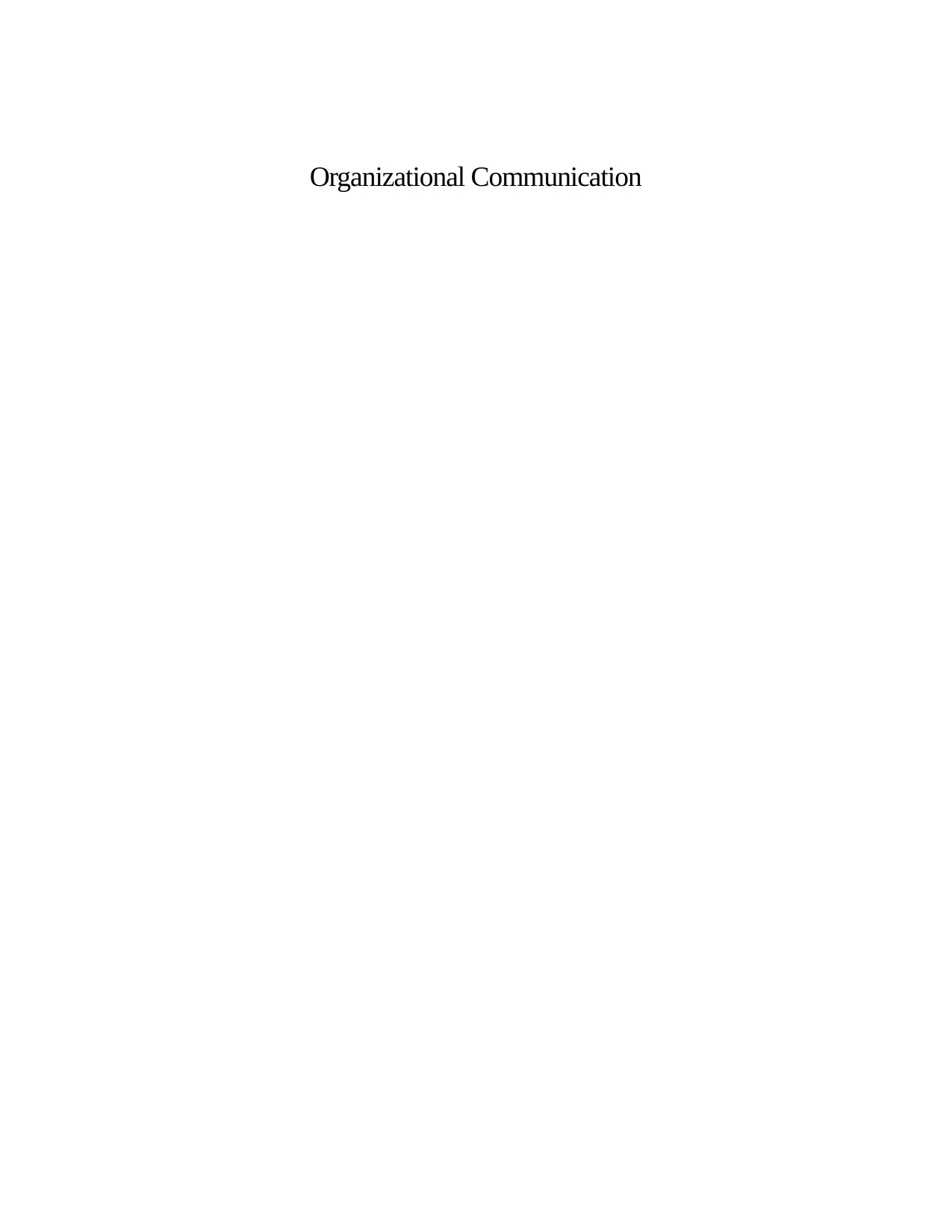
Organizational Communication
Secure Best Marks with AI Grader
Need help grading? Try our AI Grader for instant feedback on your assignments.
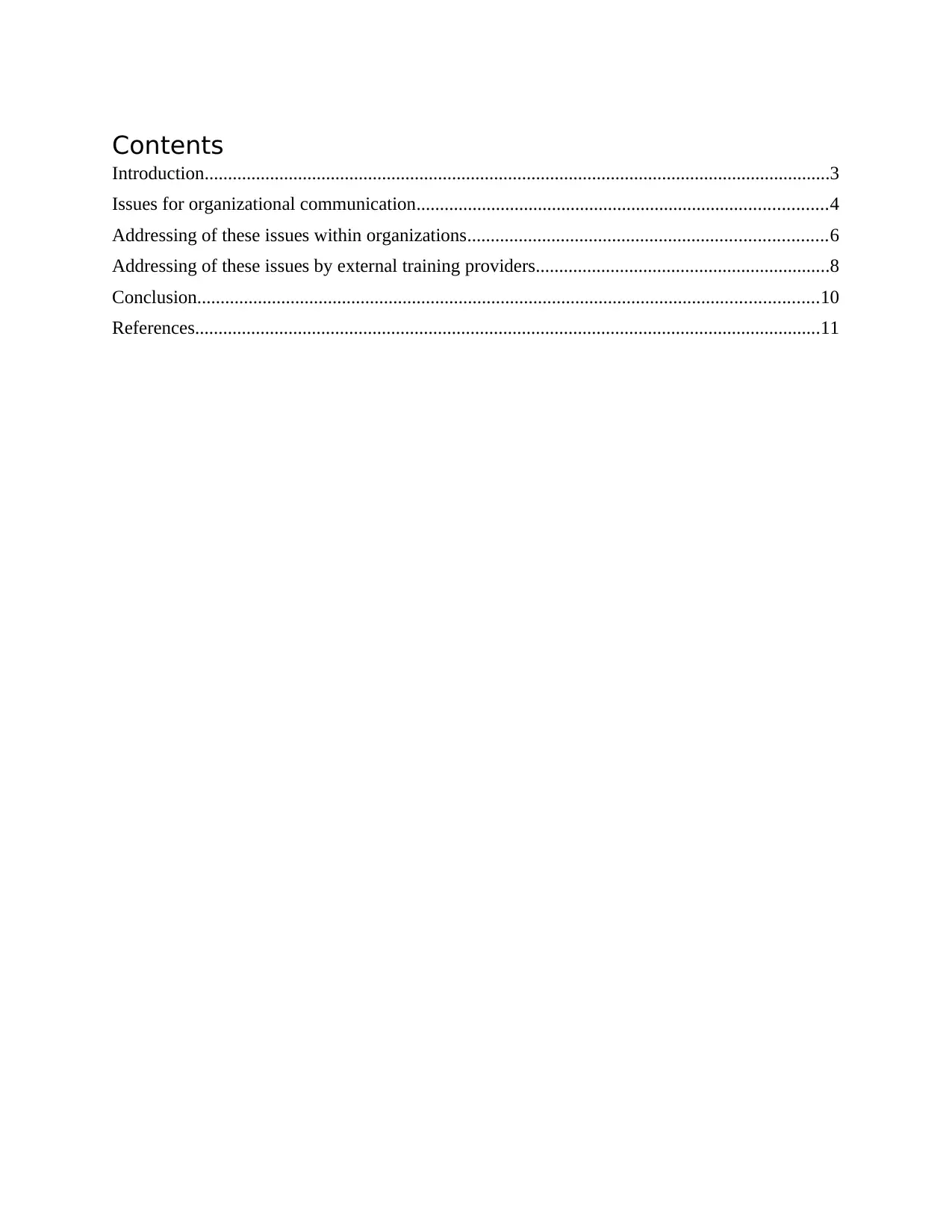
Contents
Introduction......................................................................................................................................3
Issues for organizational communication........................................................................................4
Addressing of these issues within organizations.............................................................................6
Addressing of these issues by external training providers...............................................................8
Conclusion.....................................................................................................................................10
References......................................................................................................................................11
Introduction......................................................................................................................................3
Issues for organizational communication........................................................................................4
Addressing of these issues within organizations.............................................................................6
Addressing of these issues by external training providers...............................................................8
Conclusion.....................................................................................................................................10
References......................................................................................................................................11
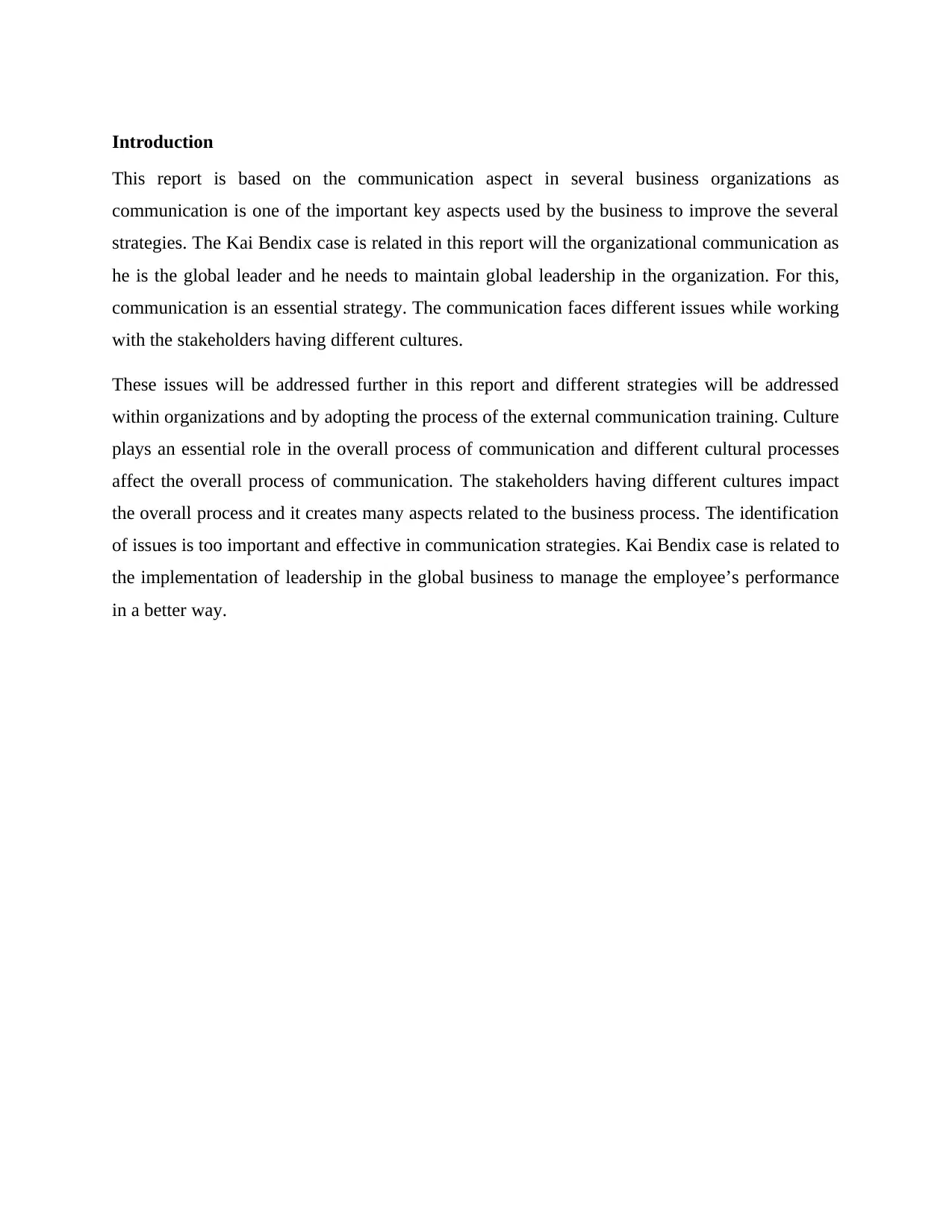
Introduction
This report is based on the communication aspect in several business organizations as
communication is one of the important key aspects used by the business to improve the several
strategies. The Kai Bendix case is related in this report will the organizational communication as
he is the global leader and he needs to maintain global leadership in the organization. For this,
communication is an essential strategy. The communication faces different issues while working
with the stakeholders having different cultures.
These issues will be addressed further in this report and different strategies will be addressed
within organizations and by adopting the process of the external communication training. Culture
plays an essential role in the overall process of communication and different cultural processes
affect the overall process of communication. The stakeholders having different cultures impact
the overall process and it creates many aspects related to the business process. The identification
of issues is too important and effective in communication strategies. Kai Bendix case is related to
the implementation of leadership in the global business to manage the employee’s performance
in a better way.
This report is based on the communication aspect in several business organizations as
communication is one of the important key aspects used by the business to improve the several
strategies. The Kai Bendix case is related in this report will the organizational communication as
he is the global leader and he needs to maintain global leadership in the organization. For this,
communication is an essential strategy. The communication faces different issues while working
with the stakeholders having different cultures.
These issues will be addressed further in this report and different strategies will be addressed
within organizations and by adopting the process of the external communication training. Culture
plays an essential role in the overall process of communication and different cultural processes
affect the overall process of communication. The stakeholders having different cultures impact
the overall process and it creates many aspects related to the business process. The identification
of issues is too important and effective in communication strategies. Kai Bendix case is related to
the implementation of leadership in the global business to manage the employee’s performance
in a better way.
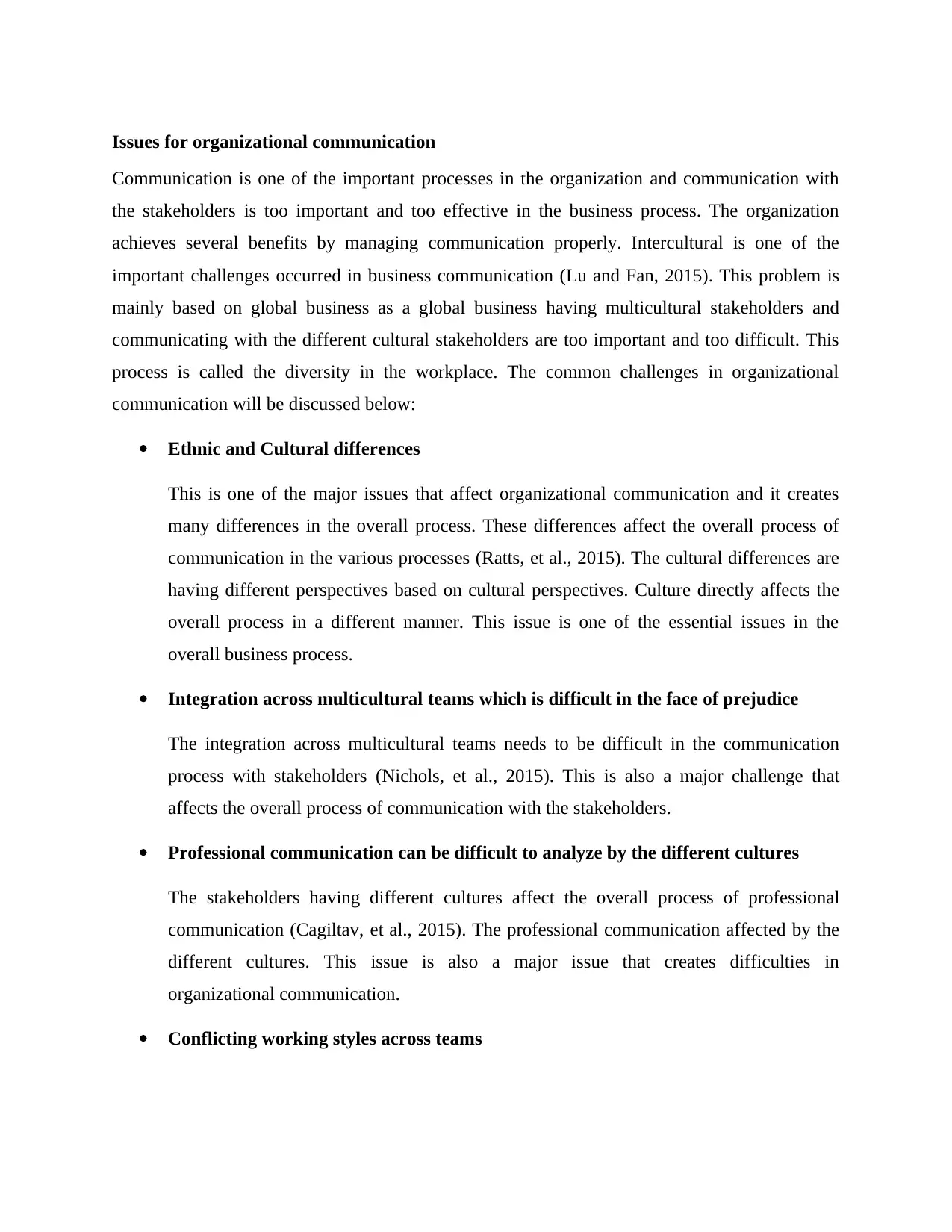
Issues for organizational communication
Communication is one of the important processes in the organization and communication with
the stakeholders is too important and too effective in the business process. The organization
achieves several benefits by managing communication properly. Intercultural is one of the
important challenges occurred in business communication (Lu and Fan, 2015). This problem is
mainly based on global business as a global business having multicultural stakeholders and
communicating with the different cultural stakeholders are too important and too difficult. This
process is called the diversity in the workplace. The common challenges in organizational
communication will be discussed below:
Ethnic and Cultural differences
This is one of the major issues that affect organizational communication and it creates
many differences in the overall process. These differences affect the overall process of
communication in the various processes (Ratts, et al., 2015). The cultural differences are
having different perspectives based on cultural perspectives. Culture directly affects the
overall process in a different manner. This issue is one of the essential issues in the
overall business process.
Integration across multicultural teams which is difficult in the face of prejudice
The integration across multicultural teams needs to be difficult in the communication
process with stakeholders (Nichols, et al., 2015). This is also a major challenge that
affects the overall process of communication with the stakeholders.
Professional communication can be difficult to analyze by the different cultures
The stakeholders having different cultures affect the overall process of professional
communication (Cagiltav, et al., 2015). The professional communication affected by the
different cultures. This issue is also a major issue that creates difficulties in
organizational communication.
Conflicting working styles across teams
Communication is one of the important processes in the organization and communication with
the stakeholders is too important and too effective in the business process. The organization
achieves several benefits by managing communication properly. Intercultural is one of the
important challenges occurred in business communication (Lu and Fan, 2015). This problem is
mainly based on global business as a global business having multicultural stakeholders and
communicating with the different cultural stakeholders are too important and too difficult. This
process is called the diversity in the workplace. The common challenges in organizational
communication will be discussed below:
Ethnic and Cultural differences
This is one of the major issues that affect organizational communication and it creates
many differences in the overall process. These differences affect the overall process of
communication in the various processes (Ratts, et al., 2015). The cultural differences are
having different perspectives based on cultural perspectives. Culture directly affects the
overall process in a different manner. This issue is one of the essential issues in the
overall business process.
Integration across multicultural teams which is difficult in the face of prejudice
The integration across multicultural teams needs to be difficult in the communication
process with stakeholders (Nichols, et al., 2015). This is also a major challenge that
affects the overall process of communication with the stakeholders.
Professional communication can be difficult to analyze by the different cultures
The stakeholders having different cultures affect the overall process of professional
communication (Cagiltav, et al., 2015). The professional communication affected by the
different cultures. This issue is also a major issue that creates difficulties in
organizational communication.
Conflicting working styles across teams
Secure Best Marks with AI Grader
Need help grading? Try our AI Grader for instant feedback on your assignments.
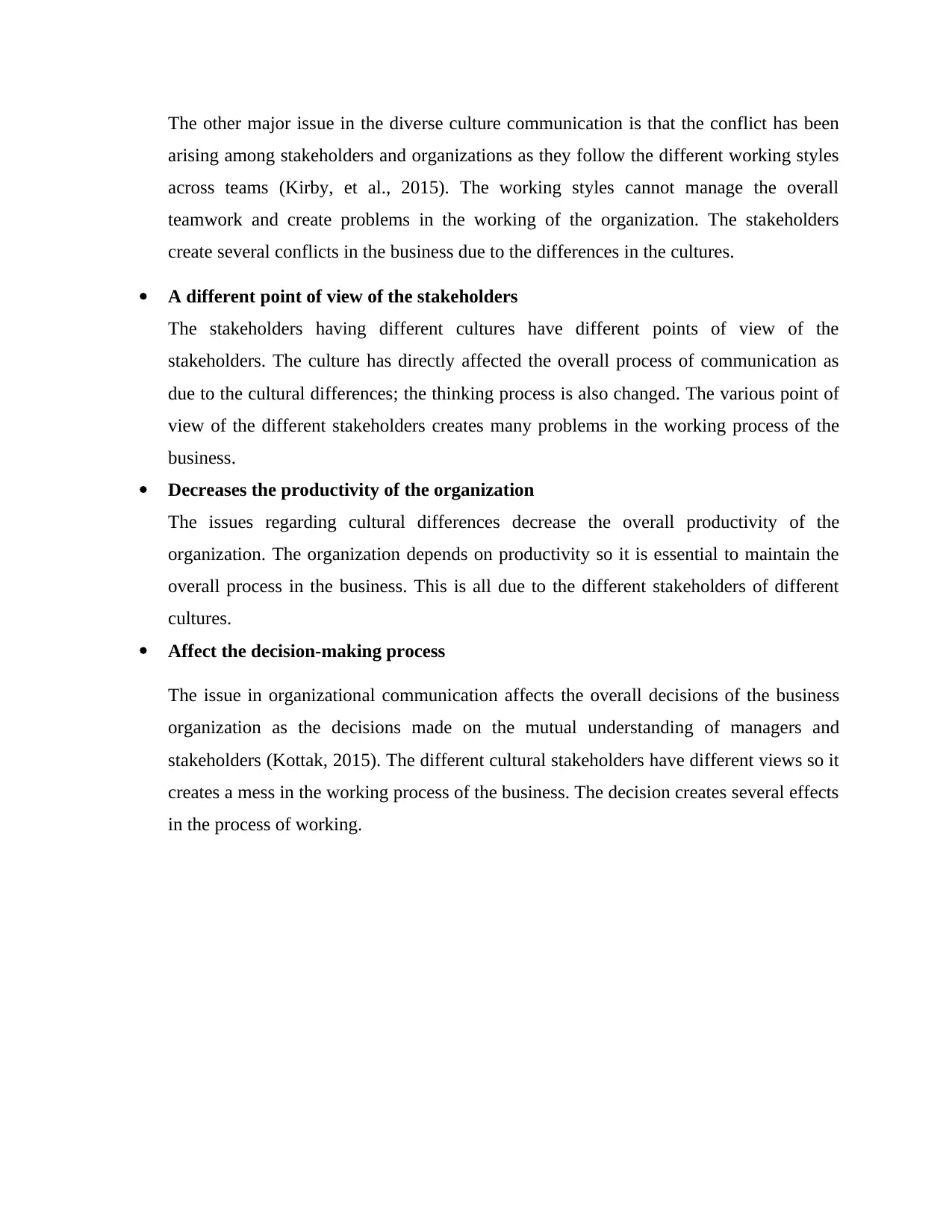
The other major issue in the diverse culture communication is that the conflict has been
arising among stakeholders and organizations as they follow the different working styles
across teams (Kirby, et al., 2015). The working styles cannot manage the overall
teamwork and create problems in the working of the organization. The stakeholders
create several conflicts in the business due to the differences in the cultures.
A different point of view of the stakeholders
The stakeholders having different cultures have different points of view of the
stakeholders. The culture has directly affected the overall process of communication as
due to the cultural differences; the thinking process is also changed. The various point of
view of the different stakeholders creates many problems in the working process of the
business.
Decreases the productivity of the organization
The issues regarding cultural differences decrease the overall productivity of the
organization. The organization depends on productivity so it is essential to maintain the
overall process in the business. This is all due to the different stakeholders of different
cultures.
Affect the decision-making process
The issue in organizational communication affects the overall decisions of the business
organization as the decisions made on the mutual understanding of managers and
stakeholders (Kottak, 2015). The different cultural stakeholders have different views so it
creates a mess in the working process of the business. The decision creates several effects
in the process of working.
arising among stakeholders and organizations as they follow the different working styles
across teams (Kirby, et al., 2015). The working styles cannot manage the overall
teamwork and create problems in the working of the organization. The stakeholders
create several conflicts in the business due to the differences in the cultures.
A different point of view of the stakeholders
The stakeholders having different cultures have different points of view of the
stakeholders. The culture has directly affected the overall process of communication as
due to the cultural differences; the thinking process is also changed. The various point of
view of the different stakeholders creates many problems in the working process of the
business.
Decreases the productivity of the organization
The issues regarding cultural differences decrease the overall productivity of the
organization. The organization depends on productivity so it is essential to maintain the
overall process in the business. This is all due to the different stakeholders of different
cultures.
Affect the decision-making process
The issue in organizational communication affects the overall decisions of the business
organization as the decisions made on the mutual understanding of managers and
stakeholders (Kottak, 2015). The different cultural stakeholders have different views so it
creates a mess in the working process of the business. The decision creates several effects
in the process of working.
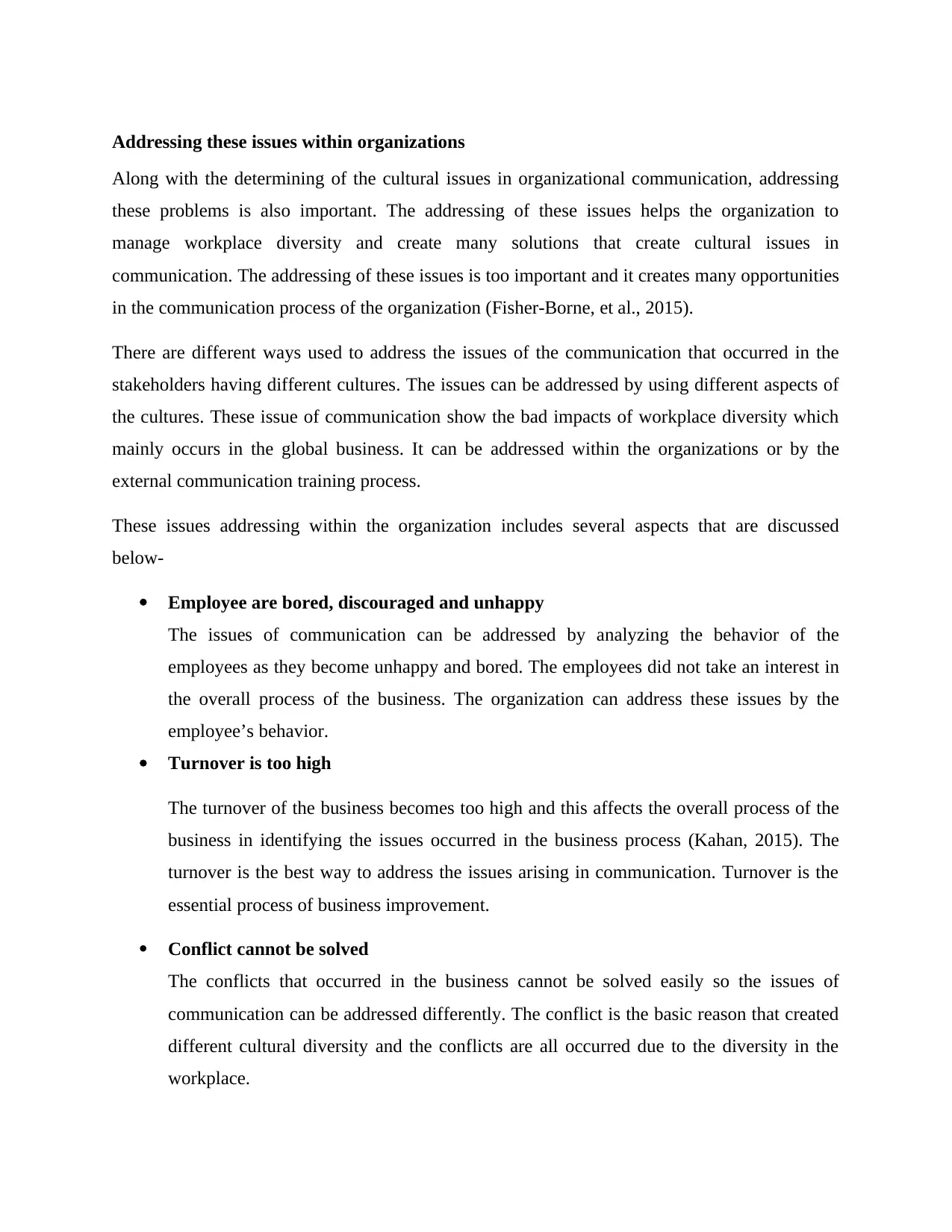
Addressing these issues within organizations
Along with the determining of the cultural issues in organizational communication, addressing
these problems is also important. The addressing of these issues helps the organization to
manage workplace diversity and create many solutions that create cultural issues in
communication. The addressing of these issues is too important and it creates many opportunities
in the communication process of the organization (Fisher-Borne, et al., 2015).
There are different ways used to address the issues of the communication that occurred in the
stakeholders having different cultures. The issues can be addressed by using different aspects of
the cultures. These issue of communication show the bad impacts of workplace diversity which
mainly occurs in the global business. It can be addressed within the organizations or by the
external communication training process.
These issues addressing within the organization includes several aspects that are discussed
below-
Employee are bored, discouraged and unhappy
The issues of communication can be addressed by analyzing the behavior of the
employees as they become unhappy and bored. The employees did not take an interest in
the overall process of the business. The organization can address these issues by the
employee’s behavior.
Turnover is too high
The turnover of the business becomes too high and this affects the overall process of the
business in identifying the issues occurred in the business process (Kahan, 2015). The
turnover is the best way to address the issues arising in communication. Turnover is the
essential process of business improvement.
Conflict cannot be solved
The conflicts that occurred in the business cannot be solved easily so the issues of
communication can be addressed differently. The conflict is the basic reason that created
different cultural diversity and the conflicts are all occurred due to the diversity in the
workplace.
Along with the determining of the cultural issues in organizational communication, addressing
these problems is also important. The addressing of these issues helps the organization to
manage workplace diversity and create many solutions that create cultural issues in
communication. The addressing of these issues is too important and it creates many opportunities
in the communication process of the organization (Fisher-Borne, et al., 2015).
There are different ways used to address the issues of the communication that occurred in the
stakeholders having different cultures. The issues can be addressed by using different aspects of
the cultures. These issue of communication show the bad impacts of workplace diversity which
mainly occurs in the global business. It can be addressed within the organizations or by the
external communication training process.
These issues addressing within the organization includes several aspects that are discussed
below-
Employee are bored, discouraged and unhappy
The issues of communication can be addressed by analyzing the behavior of the
employees as they become unhappy and bored. The employees did not take an interest in
the overall process of the business. The organization can address these issues by the
employee’s behavior.
Turnover is too high
The turnover of the business becomes too high and this affects the overall process of the
business in identifying the issues occurred in the business process (Kahan, 2015). The
turnover is the best way to address the issues arising in communication. Turnover is the
essential process of business improvement.
Conflict cannot be solved
The conflicts that occurred in the business cannot be solved easily so the issues of
communication can be addressed differently. The conflict is the basic reason that created
different cultural diversity and the conflicts are all occurred due to the diversity in the
workplace.
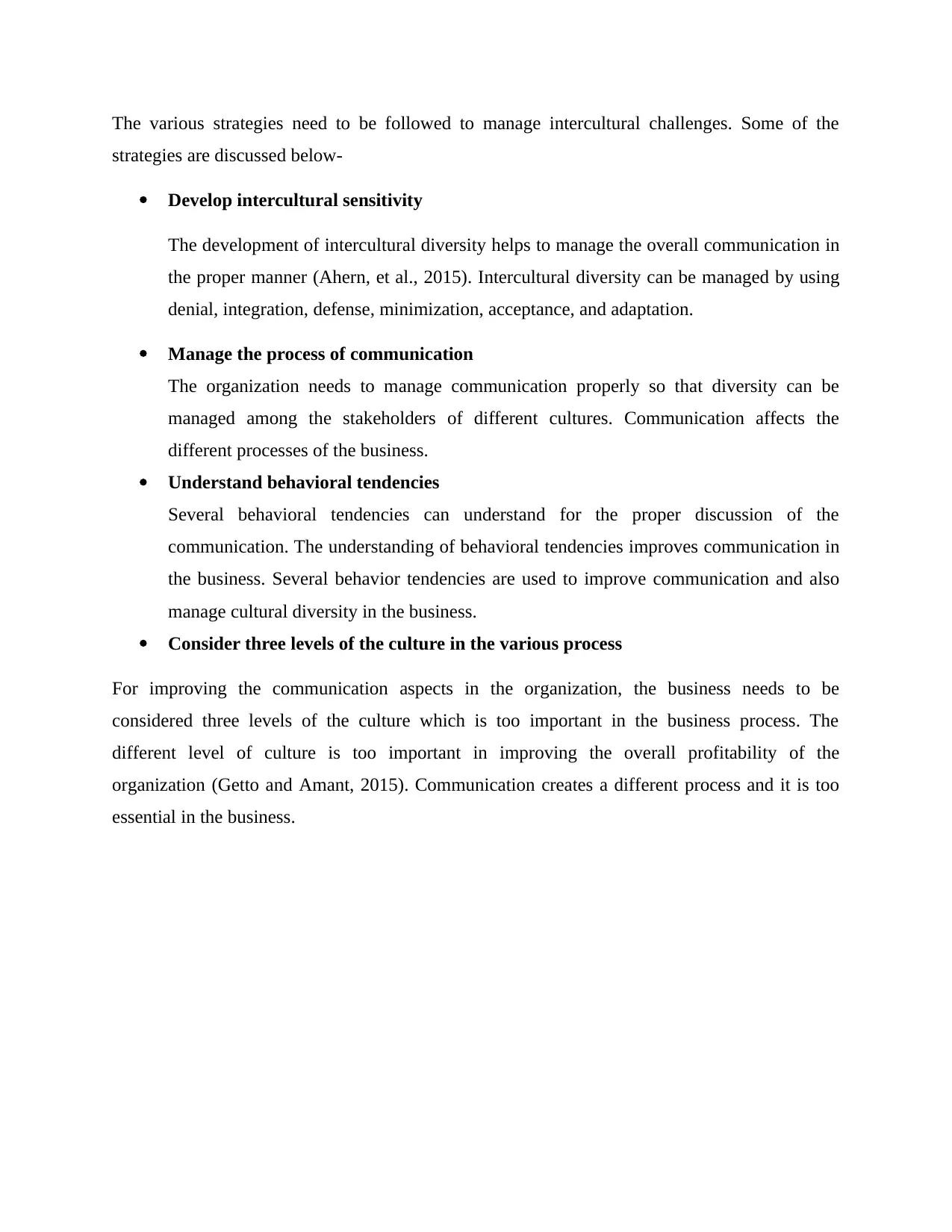
The various strategies need to be followed to manage intercultural challenges. Some of the
strategies are discussed below-
Develop intercultural sensitivity
The development of intercultural diversity helps to manage the overall communication in
the proper manner (Ahern, et al., 2015). Intercultural diversity can be managed by using
denial, integration, defense, minimization, acceptance, and adaptation.
Manage the process of communication
The organization needs to manage communication properly so that diversity can be
managed among the stakeholders of different cultures. Communication affects the
different processes of the business.
Understand behavioral tendencies
Several behavioral tendencies can understand for the proper discussion of the
communication. The understanding of behavioral tendencies improves communication in
the business. Several behavior tendencies are used to improve communication and also
manage cultural diversity in the business.
Consider three levels of the culture in the various process
For improving the communication aspects in the organization, the business needs to be
considered three levels of the culture which is too important in the business process. The
different level of culture is too important in improving the overall profitability of the
organization (Getto and Amant, 2015). Communication creates a different process and it is too
essential in the business.
strategies are discussed below-
Develop intercultural sensitivity
The development of intercultural diversity helps to manage the overall communication in
the proper manner (Ahern, et al., 2015). Intercultural diversity can be managed by using
denial, integration, defense, minimization, acceptance, and adaptation.
Manage the process of communication
The organization needs to manage communication properly so that diversity can be
managed among the stakeholders of different cultures. Communication affects the
different processes of the business.
Understand behavioral tendencies
Several behavioral tendencies can understand for the proper discussion of the
communication. The understanding of behavioral tendencies improves communication in
the business. Several behavior tendencies are used to improve communication and also
manage cultural diversity in the business.
Consider three levels of the culture in the various process
For improving the communication aspects in the organization, the business needs to be
considered three levels of the culture which is too important in the business process. The
different level of culture is too important in improving the overall profitability of the
organization (Getto and Amant, 2015). Communication creates a different process and it is too
essential in the business.
Paraphrase This Document
Need a fresh take? Get an instant paraphrase of this document with our AI Paraphraser
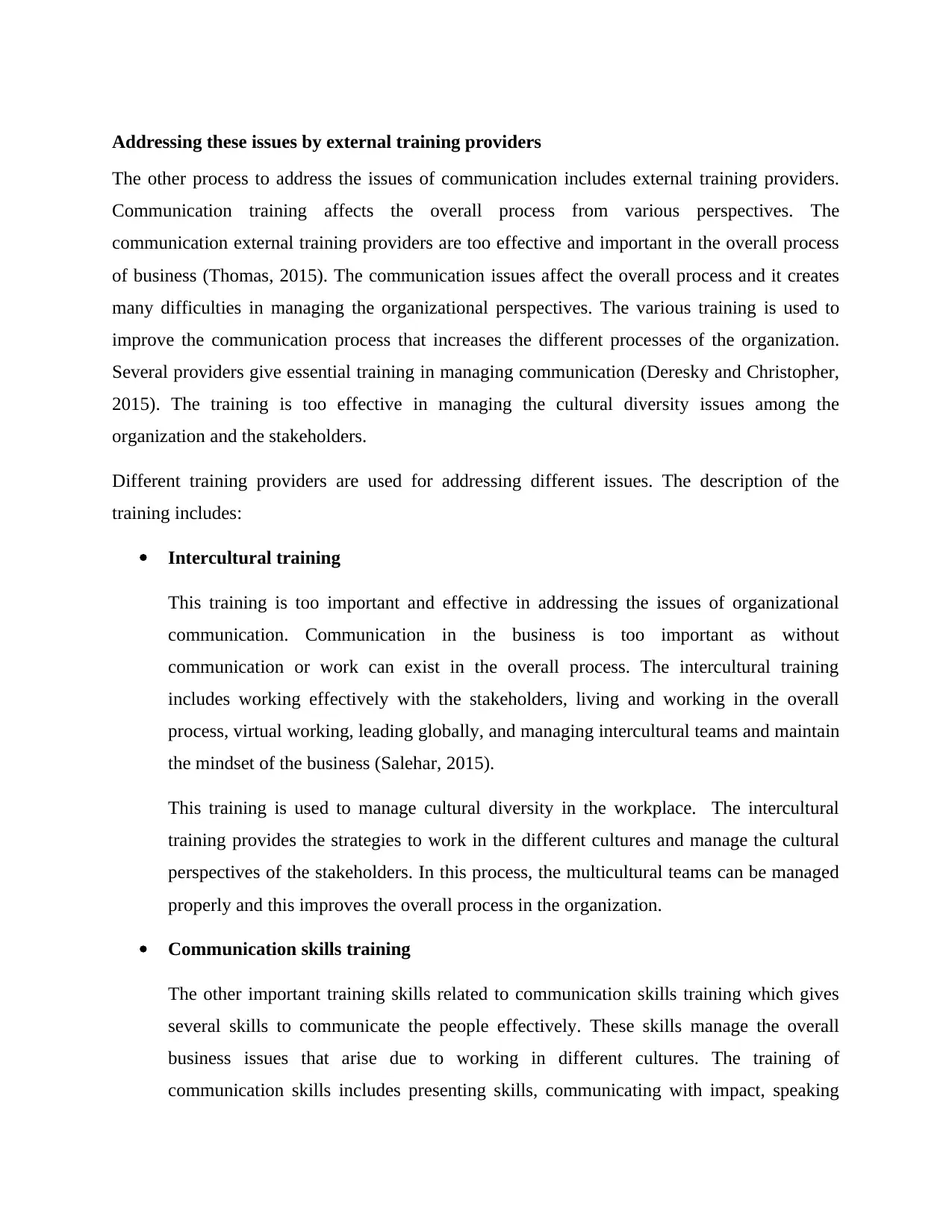
Addressing these issues by external training providers
The other process to address the issues of communication includes external training providers.
Communication training affects the overall process from various perspectives. The
communication external training providers are too effective and important in the overall process
of business (Thomas, 2015). The communication issues affect the overall process and it creates
many difficulties in managing the organizational perspectives. The various training is used to
improve the communication process that increases the different processes of the organization.
Several providers give essential training in managing communication (Deresky and Christopher,
2015). The training is too effective in managing the cultural diversity issues among the
organization and the stakeholders.
Different training providers are used for addressing different issues. The description of the
training includes:
Intercultural training
This training is too important and effective in addressing the issues of organizational
communication. Communication in the business is too important as without
communication or work can exist in the overall process. The intercultural training
includes working effectively with the stakeholders, living and working in the overall
process, virtual working, leading globally, and managing intercultural teams and maintain
the mindset of the business (Salehar, 2015).
This training is used to manage cultural diversity in the workplace. The intercultural
training provides the strategies to work in the different cultures and manage the cultural
perspectives of the stakeholders. In this process, the multicultural teams can be managed
properly and this improves the overall process in the organization.
Communication skills training
The other important training skills related to communication skills training which gives
several skills to communicate the people effectively. These skills manage the overall
business issues that arise due to working in different cultures. The training of
communication skills includes presenting skills, communicating with impact, speaking
The other process to address the issues of communication includes external training providers.
Communication training affects the overall process from various perspectives. The
communication external training providers are too effective and important in the overall process
of business (Thomas, 2015). The communication issues affect the overall process and it creates
many difficulties in managing the organizational perspectives. The various training is used to
improve the communication process that increases the different processes of the organization.
Several providers give essential training in managing communication (Deresky and Christopher,
2015). The training is too effective in managing the cultural diversity issues among the
organization and the stakeholders.
Different training providers are used for addressing different issues. The description of the
training includes:
Intercultural training
This training is too important and effective in addressing the issues of organizational
communication. Communication in the business is too important as without
communication or work can exist in the overall process. The intercultural training
includes working effectively with the stakeholders, living and working in the overall
process, virtual working, leading globally, and managing intercultural teams and maintain
the mindset of the business (Salehar, 2015).
This training is used to manage cultural diversity in the workplace. The intercultural
training provides the strategies to work in the different cultures and manage the cultural
perspectives of the stakeholders. In this process, the multicultural teams can be managed
properly and this improves the overall process in the organization.
Communication skills training
The other important training skills related to communication skills training which gives
several skills to communicate the people effectively. These skills manage the overall
business issues that arise due to working in different cultures. The training of
communication skills includes presenting skills, communicating with impact, speaking
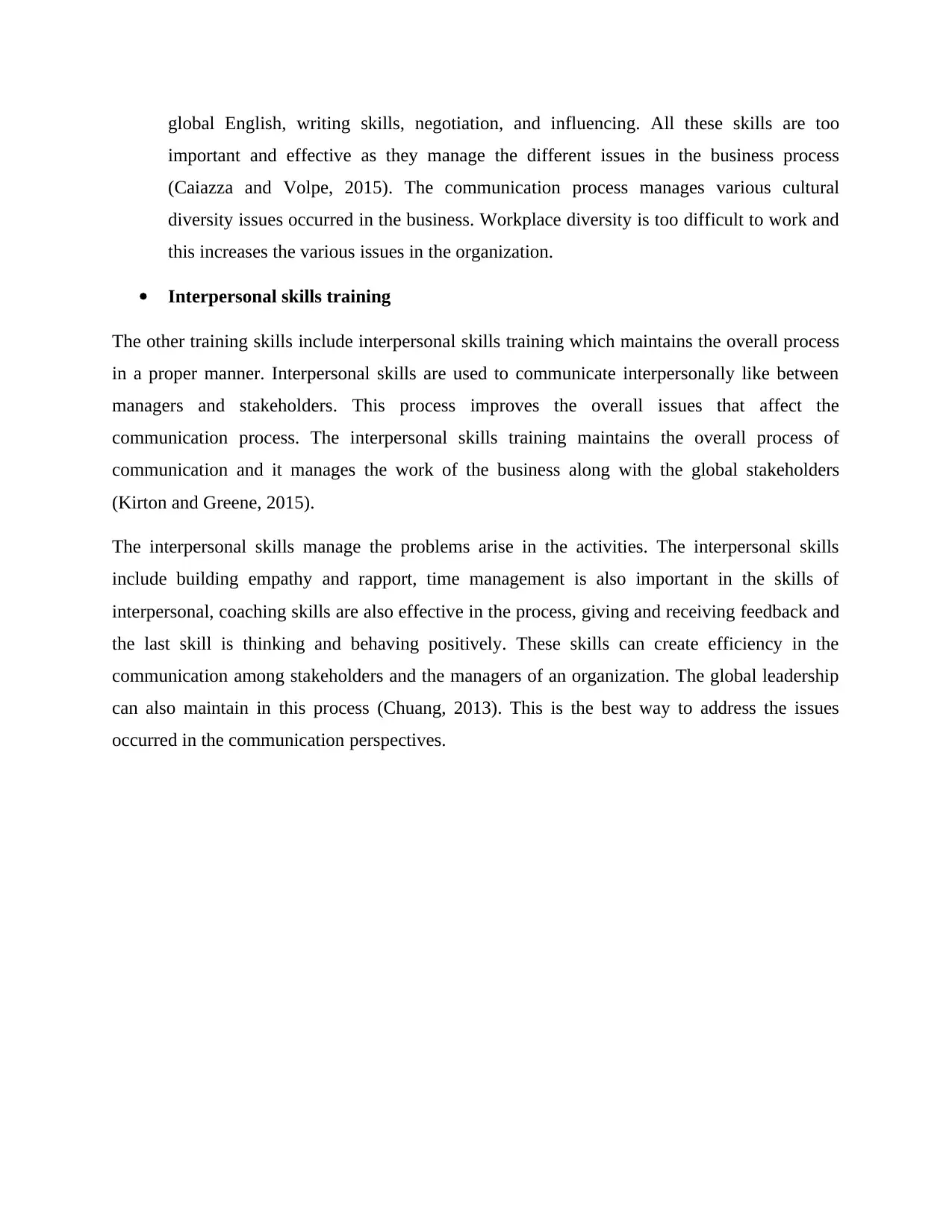
global English, writing skills, negotiation, and influencing. All these skills are too
important and effective as they manage the different issues in the business process
(Caiazza and Volpe, 2015). The communication process manages various cultural
diversity issues occurred in the business. Workplace diversity is too difficult to work and
this increases the various issues in the organization.
Interpersonal skills training
The other training skills include interpersonal skills training which maintains the overall process
in a proper manner. Interpersonal skills are used to communicate interpersonally like between
managers and stakeholders. This process improves the overall issues that affect the
communication process. The interpersonal skills training maintains the overall process of
communication and it manages the work of the business along with the global stakeholders
(Kirton and Greene, 2015).
The interpersonal skills manage the problems arise in the activities. The interpersonal skills
include building empathy and rapport, time management is also important in the skills of
interpersonal, coaching skills are also effective in the process, giving and receiving feedback and
the last skill is thinking and behaving positively. These skills can create efficiency in the
communication among stakeholders and the managers of an organization. The global leadership
can also maintain in this process (Chuang, 2013). This is the best way to address the issues
occurred in the communication perspectives.
important and effective as they manage the different issues in the business process
(Caiazza and Volpe, 2015). The communication process manages various cultural
diversity issues occurred in the business. Workplace diversity is too difficult to work and
this increases the various issues in the organization.
Interpersonal skills training
The other training skills include interpersonal skills training which maintains the overall process
in a proper manner. Interpersonal skills are used to communicate interpersonally like between
managers and stakeholders. This process improves the overall issues that affect the
communication process. The interpersonal skills training maintains the overall process of
communication and it manages the work of the business along with the global stakeholders
(Kirton and Greene, 2015).
The interpersonal skills manage the problems arise in the activities. The interpersonal skills
include building empathy and rapport, time management is also important in the skills of
interpersonal, coaching skills are also effective in the process, giving and receiving feedback and
the last skill is thinking and behaving positively. These skills can create efficiency in the
communication among stakeholders and the managers of an organization. The global leadership
can also maintain in this process (Chuang, 2013). This is the best way to address the issues
occurred in the communication perspectives.
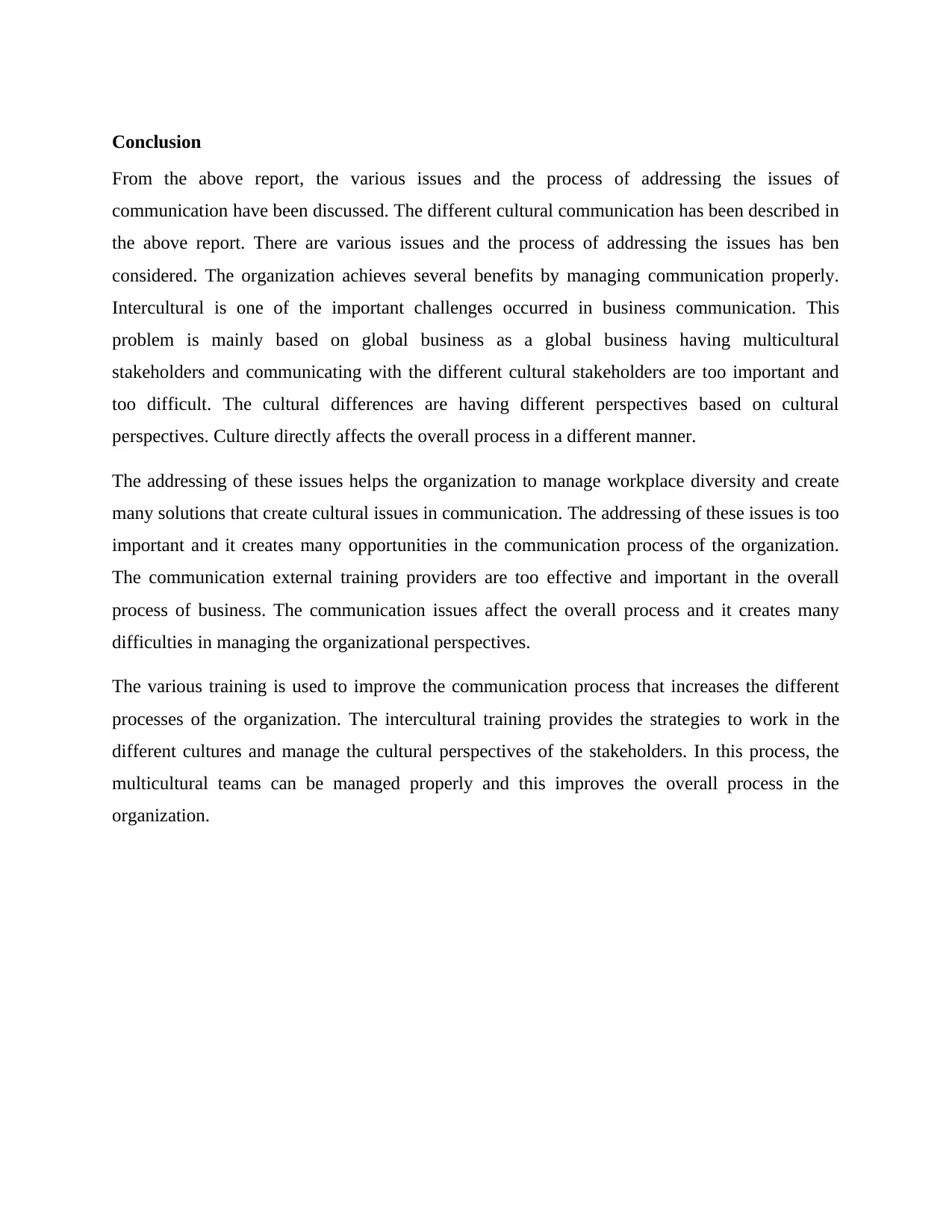
Conclusion
From the above report, the various issues and the process of addressing the issues of
communication have been discussed. The different cultural communication has been described in
the above report. There are various issues and the process of addressing the issues has ben
considered. The organization achieves several benefits by managing communication properly.
Intercultural is one of the important challenges occurred in business communication. This
problem is mainly based on global business as a global business having multicultural
stakeholders and communicating with the different cultural stakeholders are too important and
too difficult. The cultural differences are having different perspectives based on cultural
perspectives. Culture directly affects the overall process in a different manner.
The addressing of these issues helps the organization to manage workplace diversity and create
many solutions that create cultural issues in communication. The addressing of these issues is too
important and it creates many opportunities in the communication process of the organization.
The communication external training providers are too effective and important in the overall
process of business. The communication issues affect the overall process and it creates many
difficulties in managing the organizational perspectives.
The various training is used to improve the communication process that increases the different
processes of the organization. The intercultural training provides the strategies to work in the
different cultures and manage the cultural perspectives of the stakeholders. In this process, the
multicultural teams can be managed properly and this improves the overall process in the
organization.
From the above report, the various issues and the process of addressing the issues of
communication have been discussed. The different cultural communication has been described in
the above report. There are various issues and the process of addressing the issues has ben
considered. The organization achieves several benefits by managing communication properly.
Intercultural is one of the important challenges occurred in business communication. This
problem is mainly based on global business as a global business having multicultural
stakeholders and communicating with the different cultural stakeholders are too important and
too difficult. The cultural differences are having different perspectives based on cultural
perspectives. Culture directly affects the overall process in a different manner.
The addressing of these issues helps the organization to manage workplace diversity and create
many solutions that create cultural issues in communication. The addressing of these issues is too
important and it creates many opportunities in the communication process of the organization.
The communication external training providers are too effective and important in the overall
process of business. The communication issues affect the overall process and it creates many
difficulties in managing the organizational perspectives.
The various training is used to improve the communication process that increases the different
processes of the organization. The intercultural training provides the strategies to work in the
different cultures and manage the cultural perspectives of the stakeholders. In this process, the
multicultural teams can be managed properly and this improves the overall process in the
organization.
Secure Best Marks with AI Grader
Need help grading? Try our AI Grader for instant feedback on your assignments.
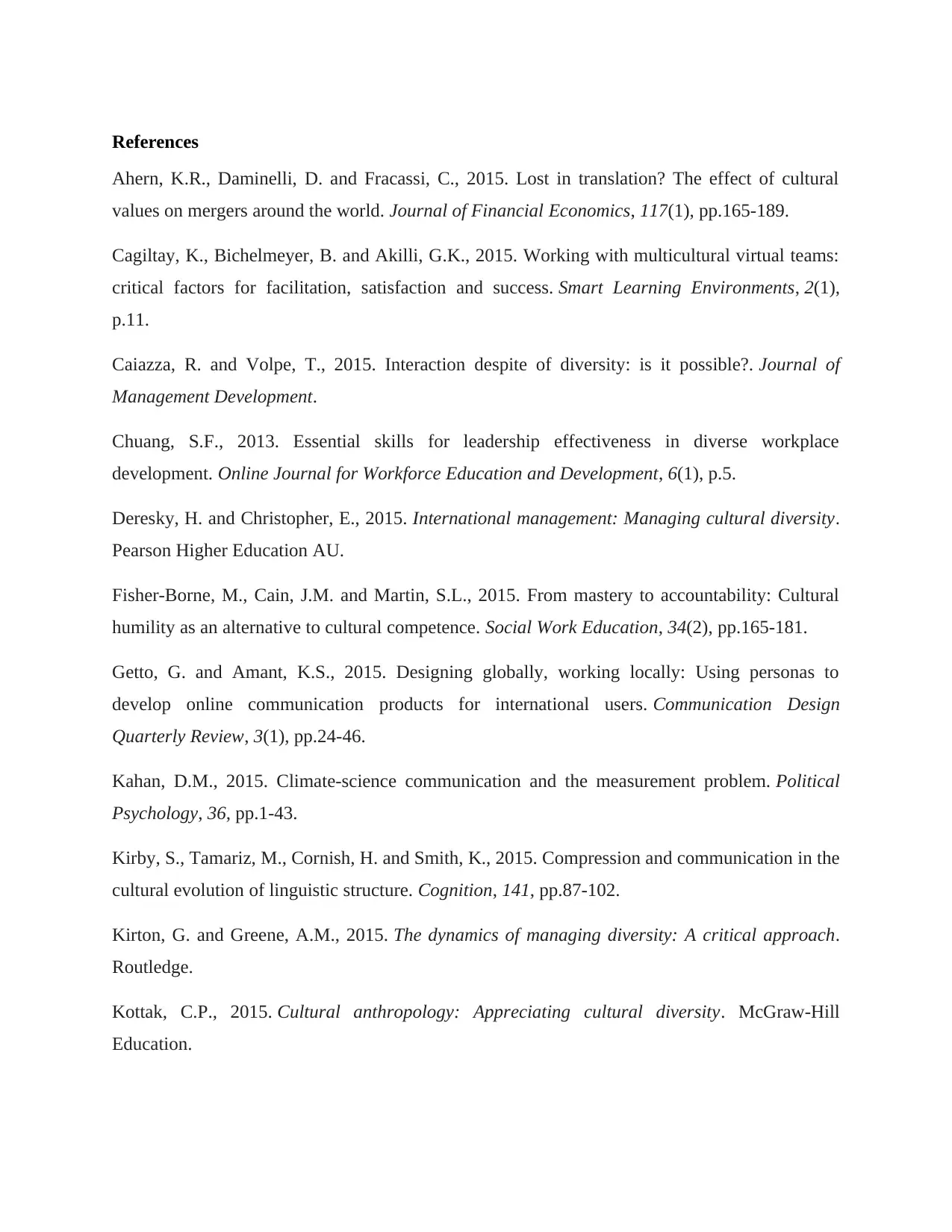
References
Ahern, K.R., Daminelli, D. and Fracassi, C., 2015. Lost in translation? The effect of cultural
values on mergers around the world. Journal of Financial Economics, 117(1), pp.165-189.
Cagiltay, K., Bichelmeyer, B. and Akilli, G.K., 2015. Working with multicultural virtual teams:
critical factors for facilitation, satisfaction and success. Smart Learning Environments, 2(1),
p.11.
Caiazza, R. and Volpe, T., 2015. Interaction despite of diversity: is it possible?. Journal of
Management Development.
Chuang, S.F., 2013. Essential skills for leadership effectiveness in diverse workplace
development. Online Journal for Workforce Education and Development, 6(1), p.5.
Deresky, H. and Christopher, E., 2015. International management: Managing cultural diversity.
Pearson Higher Education AU.
Fisher-Borne, M., Cain, J.M. and Martin, S.L., 2015. From mastery to accountability: Cultural
humility as an alternative to cultural competence. Social Work Education, 34(2), pp.165-181.
Getto, G. and Amant, K.S., 2015. Designing globally, working locally: Using personas to
develop online communication products for international users. Communication Design
Quarterly Review, 3(1), pp.24-46.
Kahan, D.M., 2015. Climate‐science communication and the measurement problem. Political
Psychology, 36, pp.1-43.
Kirby, S., Tamariz, M., Cornish, H. and Smith, K., 2015. Compression and communication in the
cultural evolution of linguistic structure. Cognition, 141, pp.87-102.
Kirton, G. and Greene, A.M., 2015. The dynamics of managing diversity: A critical approach.
Routledge.
Kottak, C.P., 2015. Cultural anthropology: Appreciating cultural diversity. McGraw-Hill
Education.
Ahern, K.R., Daminelli, D. and Fracassi, C., 2015. Lost in translation? The effect of cultural
values on mergers around the world. Journal of Financial Economics, 117(1), pp.165-189.
Cagiltay, K., Bichelmeyer, B. and Akilli, G.K., 2015. Working with multicultural virtual teams:
critical factors for facilitation, satisfaction and success. Smart Learning Environments, 2(1),
p.11.
Caiazza, R. and Volpe, T., 2015. Interaction despite of diversity: is it possible?. Journal of
Management Development.
Chuang, S.F., 2013. Essential skills for leadership effectiveness in diverse workplace
development. Online Journal for Workforce Education and Development, 6(1), p.5.
Deresky, H. and Christopher, E., 2015. International management: Managing cultural diversity.
Pearson Higher Education AU.
Fisher-Borne, M., Cain, J.M. and Martin, S.L., 2015. From mastery to accountability: Cultural
humility as an alternative to cultural competence. Social Work Education, 34(2), pp.165-181.
Getto, G. and Amant, K.S., 2015. Designing globally, working locally: Using personas to
develop online communication products for international users. Communication Design
Quarterly Review, 3(1), pp.24-46.
Kahan, D.M., 2015. Climate‐science communication and the measurement problem. Political
Psychology, 36, pp.1-43.
Kirby, S., Tamariz, M., Cornish, H. and Smith, K., 2015. Compression and communication in the
cultural evolution of linguistic structure. Cognition, 141, pp.87-102.
Kirton, G. and Greene, A.M., 2015. The dynamics of managing diversity: A critical approach.
Routledge.
Kottak, C.P., 2015. Cultural anthropology: Appreciating cultural diversity. McGraw-Hill
Education.
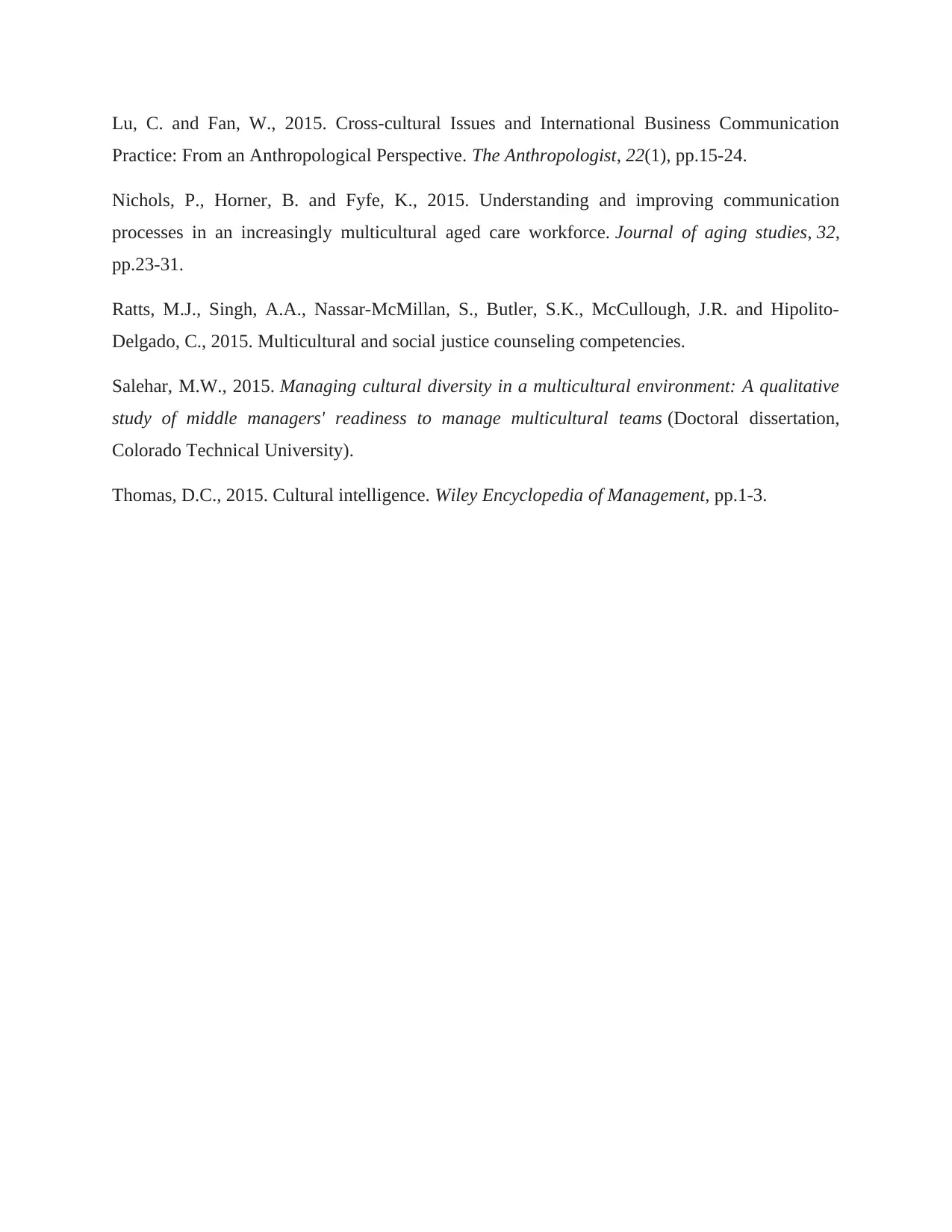
Lu, C. and Fan, W., 2015. Cross-cultural Issues and International Business Communication
Practice: From an Anthropological Perspective. The Anthropologist, 22(1), pp.15-24.
Nichols, P., Horner, B. and Fyfe, K., 2015. Understanding and improving communication
processes in an increasingly multicultural aged care workforce. Journal of aging studies, 32,
pp.23-31.
Ratts, M.J., Singh, A.A., Nassar-McMillan, S., Butler, S.K., McCullough, J.R. and Hipolito-
Delgado, C., 2015. Multicultural and social justice counseling competencies.
Salehar, M.W., 2015. Managing cultural diversity in a multicultural environment: A qualitative
study of middle managers' readiness to manage multicultural teams (Doctoral dissertation,
Colorado Technical University).
Thomas, D.C., 2015. Cultural intelligence. Wiley Encyclopedia of Management, pp.1-3.
Practice: From an Anthropological Perspective. The Anthropologist, 22(1), pp.15-24.
Nichols, P., Horner, B. and Fyfe, K., 2015. Understanding and improving communication
processes in an increasingly multicultural aged care workforce. Journal of aging studies, 32,
pp.23-31.
Ratts, M.J., Singh, A.A., Nassar-McMillan, S., Butler, S.K., McCullough, J.R. and Hipolito-
Delgado, C., 2015. Multicultural and social justice counseling competencies.
Salehar, M.W., 2015. Managing cultural diversity in a multicultural environment: A qualitative
study of middle managers' readiness to manage multicultural teams (Doctoral dissertation,
Colorado Technical University).
Thomas, D.C., 2015. Cultural intelligence. Wiley Encyclopedia of Management, pp.1-3.
1 out of 12
Related Documents
Your All-in-One AI-Powered Toolkit for Academic Success.
+13062052269
info@desklib.com
Available 24*7 on WhatsApp / Email
![[object Object]](/_next/static/media/star-bottom.7253800d.svg)
Unlock your academic potential
© 2024 | Zucol Services PVT LTD | All rights reserved.




